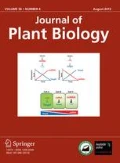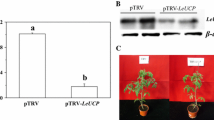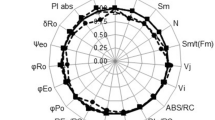Abstract
Plant mitochondrial uncoupling proteins (pUCPs) play important roles in generation of metabolic thermogenesis, response to stress situation, and regulation of energy metabolism. Although the signaling pathways for the pUCPs-regulated plant energy metabolism and thermogenesis are well studied, the role of pUCPs in the regulation of plant stress tolerance has not been fully substantiated. Here we showed that mitochondrial uncoupling protein was required for effective antioxidant enzymes activities, chlorophyll fluorescence and redox poise in tomato under oxidative stress using virusinduced gene silencing approach. Silencing of LeUCP gene reduced maximal quantum yield of PSII (Fv/Fm) and photochemical quenching coefficient (qP), as well as mitigated activation of antioxidant enzymes and related genes expression. The content of reduced ascorbate and reduced glutathione, redox ratio of ascorbate and L-galactono-1,4-lactone dehydrogenase (GalLDH; EC 1.3.2.3) activity were all decreased in the leaves of LeUCP gene-silenced plant. However, malondialdehyde content was increased under methylviologen (MV) stress. ROS accumulation was increased significantly following MV and heat stress treatments. Meanwhile, LeUCP gene silencing aggravated accumulation of H2O2 and O ·−2 in leaves. Taken together, these results strongly suggest that LeUCP gene plays critical role in maintaining the redox homeostasis and balance in antioxidant enzyme system under oxidative stress.
Similar content being viewed by others
References
Barth C, Moeder W, Klessig DF, Conklin PL (2004) The timing of senescence and response to pathogens is altered in the ascorbate-deficient Arabidopsis mutant vitamin c-1. Plant Physiol 134:1784–1792
Begcy K, Mariano ED, Mattiello L, Nunes AV, Mazzafera P, Maia IG, Menossi M (2011) An Arabidopsis mitochondrial uncoupling protein confers tolerance to drought and salt stress in transgenic tobacco plants. PLoS One 6:e23776
Bestwick CS, Brown IR, Bennett MHR, Mansfield JW (1997) Localization of hydrogen peroxide accumulation during the hypersensitive reaction of lettuce cells to Pseudomonas syringae pv phaseolicola. Plant Cell 9:209–221
Borecky J, Vercesi AE (2005) Plant uncoupling mitochondrial protein and alternative oxidase: Energy metabolism and stress. Bioscience Rep 25:271–286
Brandalise M, Maia IG, Borecky J, Vercesi AE, Arruda P (2003) Overexpression of plant uncoupling mitochondrial protein in transgenic tobacco increases tolerance to oxidative stress. J Bioenerg Biomembr 35:203–209
Cakmak I, Marschner H (1992) Magnesium deficiency and high light intensity enhance activities of super oxide dismutase ascorbate peroxidase, and glutathione reductase in bean leaves. Plant Physiol 98:1222–1227
Cheong YH, Chang HS, Gupta R, Wang X, Zhu T, Luan S (2002) Transcriptional profiling reveals novel interactions between wounding, pathogen, abiotic stress, and hormonal responses in Arabidopsis. Plant Physiol 129:661–677
Chen SC, Jin WJ, Liu AR, Liu ZM, Liu DL, Xia XJ, Lin XM. (2013) Mitochondrial uncoupling protein silence is compromised in photosynthesis and redox poise. Acta Physiol Plant 35:2547–2558
Doulis AG, Debian N, Kingston-Smith AH, Foyer CH (1997) Differential localization of antioxidants in maize leaves. Plant Physiol 114:1031–1037
Echtay KS, Roussel D, St-Pierre J, Jekabsons MB, Cadenas S, Stuart JA, Harper JA, Roebuck SJ, Morrison A, Pickering S, Clapham JC, Brand MD. (2002) Superoxide activates mitochondrial uncoupling proteins. Nature 415:96–99
Ekengren SK, Liu Y, Schiff M, Dinesh-Kumar SP, Martin GB (2003) Two MAPK cascades, NPR1, and TGA transcription factors play a role in Pto-mediated disease resistance in tomato. Plant J 36:905–917
Elstner EF, Heupel A (1976) Inhibition of nitrite formation from hydroxylammonium-chloride-simple assay for superoxide dismutase. Anal Biochem 70:616–620
Fávaro RD, Borecky J, Colombi D, Vercesi AE, Maia IG (2007) Mutational analysis of Arabidopsis thaliana plant uncoupling mitochondrial protein. BBA-Bioenergetics 1767:1412–1417
Foyer CH, Noctor G (2005) Redox homeostasis and antioxidant signaling: a metabolic interface between stress perception and physiological responses. Plant Cell 17:1866–1875
Foyer CH, Noctor G (2009) Redox regulation in photosynthetic organisms: signaling, acclimation, and practical implications. Antioxid Redox Sign 11:861–905
Goglia F, Skulachev VP (2003) A function for novel uncoupling proteins: antioxidant defense of mitochondrial matrix by translocating fatty acid peroxides from the inner to the outer membrane leaflet. FASEB J 12:1585–1591
Hodges DM, Delong JM, Forney CF, Prange RK (1999) Improving the thiobarbituric acid-reactivesubstances assay for estimating lipid peroxidation in plant tissues containing anthocyanin and other interfering compounds. Planta 207:604–611
Jarmuszkiewicz W, Woyda-Ploszczyca A, Antos-Krzeminska N, Sluse FE (2010) Mitochondrial uncoupling proteins in unicellular eukaryotes. BBA-Bioenergetics 1797:792–799
Jezek P, Costa AD, Vercesi AE (1996) Evidence for aniontranslocating plant uncoupling mitochondrial protein in potato mitochondria. J Biol Chem 271:32743–32748
Kandoth PK, Ranf S, Pancholi SS, Jayanty S, Walla MD, Miller W, Howe GA, Lincoln DE, Stratmann JW (2007) Tomato MAPKs LeMPK1, LeMPK2, and LeMPK3 function in the systeminmediated defense response against herbivorous insects. Proc Natl Acad Sci USA 104:12205–12210
Karpinski S, Reynolds H, Karpinska B, Wingsle G, Creissen G, Mullineaux P (1999) Systemic signaling and acclimation in response to excess excitation energy in Arabidopsis. Science 284:654–657
Kowaltowski AJ, Castilho RF, Vercesi AE (1996) Opening of the mitochondrial permeability transition pore by uncoupling or inorganic phosphate in the presence of Ca2+ is dependent on mitochondrial-generated reactive oxygen species. Febs Lett 378:150–152
Krauss S, Zhang CY, Lowell BB (2005) The mitochondrial uncouplingprotein homologues. Nat Rev Mol Cell Biol 6:248–261
Law MY, Charles SA, Halliwell B (1983) Glutathione and ascorbicacid in spinach (Spinacia oleracea) chloroplasts — the effect of hydrogen-peroxide and of paraquat. Biochem J 210:899–903
Li Z, Wakao S, Fischer BB, Niyogi KK (2009) Sensing and responding to excess light. Annu Rev Plant Biol 60:239–260
Livak KJ, Schmittgen TD (2001) Analysis of relative gene expression data using real-time quantitative PCR and the 2-ΔΔCT method. Methods 25:402–408
Maia IG, Benedetti CE, Leite A, Turcinelli SR, Vercesi AE, Arruda P (1998) AtPUMP: an Arabidopsis gene encoding a plant uncoupling mitochondrial protein. Febs Lett 429:403–406
Maxwell DP, Nickels R, Mcintosh L (2002) Evidence of mitochondrial involvement in the transduction of signals required for the induction of genes associated with pathogen attack and senescence. Plant J 29:269–279
Mittler R, Vanderauwera S, Gollery M, Van Breusegem F (2004) Reactive oxygen gene network of plants. Trends Plant Sci 9:490–498
Nakano Y, Asada K (1981) Hydrogen peroxide is scavenged by ascorbate-specific peroxidase in spinach chloroplasts. Plant Cell Physiol 22:867–880
Nogueira FTS, Sassaki FT, Maia IG (2011) Arabidopsis thaliana uncoupling proteins (AtUCPs): insights into gene expression during development and stress response and epigenetic regulation. J Bioenerg Biomembr 43:71–79
Ozawa K, Murayama S, Kobayashi-Uehara A, Handa H (2006) Overexpression of wheat mitochondrial uncoupling protein in rice plants confers tolerances to oxidative stresses promoted by exogenous hydrogen peroxide and low temperature. Mol Breeding 18:51–56
Pastore D, Trono D, Laus MN, Di Fonzo N, Flagella Z (2007) Possible plant mitochondria involvement in cell adaptation to drought stress. A case study: durum wheat mitochondria. J Exp Bot 58:195–210
Panda SK, Sahoo L, Katsuhara M, Matsumoto H (2013) Overexpression of alternative oxidase gene confers aluminum tolerance by altering the respiratory capacity and the response to oxidative stress in tobacco cells. Mol Biotechnol 54:551–563
Popov VN, Eprintsev AT, Maltseva EV (2011) Activation of genes encoding mitochondrial proteins involved in alternative and uncoupled respiration of tomato plants treated with low temperature and reactive oxygen species. Russ J Plant Physiol 58:914–920
Rao MV, Ormrod DP (1995) Impact of UVB and O3 on the oxygenfree radical scavenging system in Arabidopsis thaliana genotypes differing in flavonoid biosynthesis. Photochem Photobiol 62:719–726
Shan CJ, Liang ZS (2010) Jasmonic acid regulates ascorbate and glutathione metabolism in Agropyron cristatum leaves under water stress. Plant Sci 178:130–139
Smith AMO, Ratcliffe RG, Sweetlove LJ (2004) Activation and function of mitochondrial uncoupling protein in plants. J Bioll Chem 279:51944–51952
Stewart RRC, Bewley JD (1980) Lipid-peroxidation associated with accelerated aging of soybean axes. Plant Physiol 65:245–248
Suzuki N, Koussevitzky S, Mittler R, Miller G (2012) ROS and redox signalling in the response of plants to abiotic stress. Plant Cell Environ 35:259–270
Sweetlove LJ, Lytovchenko A, Morgan M, Nunes-Nesi A, Taylor NL, Baxter CJ, Eickmeier I, Fernie AR (2006) Mitochondrial uncoupling protein is required for efficient photosynthesis. Proc Natl Acad Sci USA 103:19587–19592
Swidzinski JA, Sweetlove LJ, Leaver CJ (2002) A custom microarray analysis of gene expression during programmed cell death in Arabidopsis thaliana. Plant J 30:431–446
Trono D, Flagella Z, Laus MN, Di Fonzo N, Pastore D (2004) The uncoupling protein and the potassium channel are activated by hyperosmotic stress in mitochondria from durum wheat seedlings. Plant Cell Environ 27:437–448
van Kooten O, Snel JFH (1990) The use of chlorophyll fluorescence nomenclature in plant stress physiology. Photosynth Res 25:147–150
Vercesi AE, Borecky J, Godoy Maia ID, Arruda P, Cuccovia IM, Chaimovich H (2006) Plant uncoupling mitochondrial proteins. Annu Rev Plant Biol 57:383–404
Vianello A, Macri F, Braidot E, Mokhova EN (1995) Effect of 6-ketocholestanol on FCCP- and DNP-induced uncoupling in plant mitochondria. FEBS Lett 365:7–9
Willekens H, Chamnongpol S, Davey M, Schraudner M, Langebartels C, Van Montagu M, Inzé D, Van Camp W. (1997) Catalase is a sink for H2O2 and is indispensable for stress defence in C3 plants. EMBO J 16:4806–4816
Xia XJ, Wang YJ, Zhou YH, Tao Y, Mao WH, Shi K, Asami T, Chen ZX, Yu JQ. (2009) Reactive oxygen species are involved in Brassinosteroid-induced stress tolerance in cucumber. Plant Physiol 150:801–814
Zai XM, Zhu SN, Qin P, Wang XY, Che L, Luo FX (2012) Effect of Glomus mosseae on chlorophyll content, chlorophyll fluorescence parameters, and chloroplast ultrastructure of beach plum (Prunus maritima) under NaCl stress. Photosynthetica 50:323–328
Zhu Y, Lu JF, Wang J, Chen F, Leng FF, Li HY (2011) Regulation of thermogenesis in plants: the interaction of alternative oxidase and plant uncoupling mitochondrial protein. J Integr Plant Biol 53:7–13
Author information
Authors and Affiliations
Corresponding authors
Rights and permissions
About this article
Cite this article
Chen, S., Liu, A., Ji, D. et al. Silencing of tomato mitochondrial uncoupling protein disrupts redox poise and antioxidant enzymes activities balance under oxidative stress. J. Plant Biol. 57, 9–19 (2014). https://doi.org/10.1007/s12374-013-0350-9
Received:
Accepted:
Published:
Issue Date:
DOI: https://doi.org/10.1007/s12374-013-0350-9




